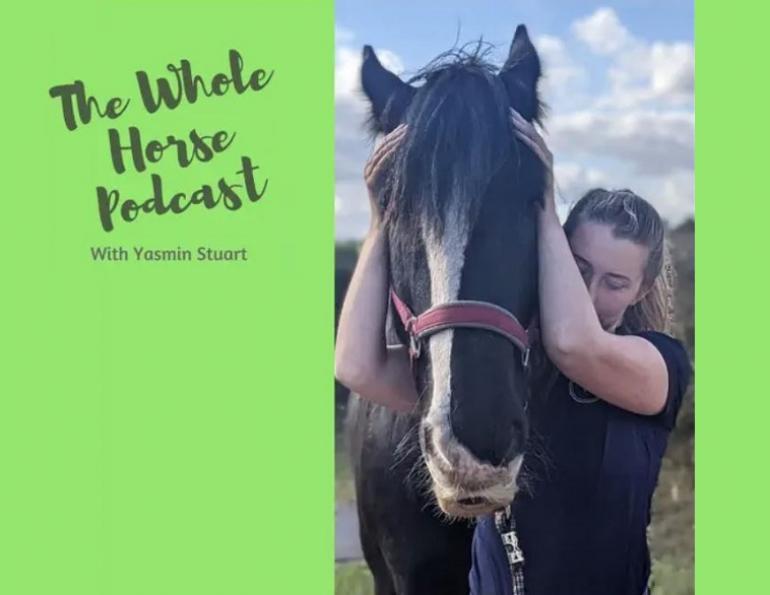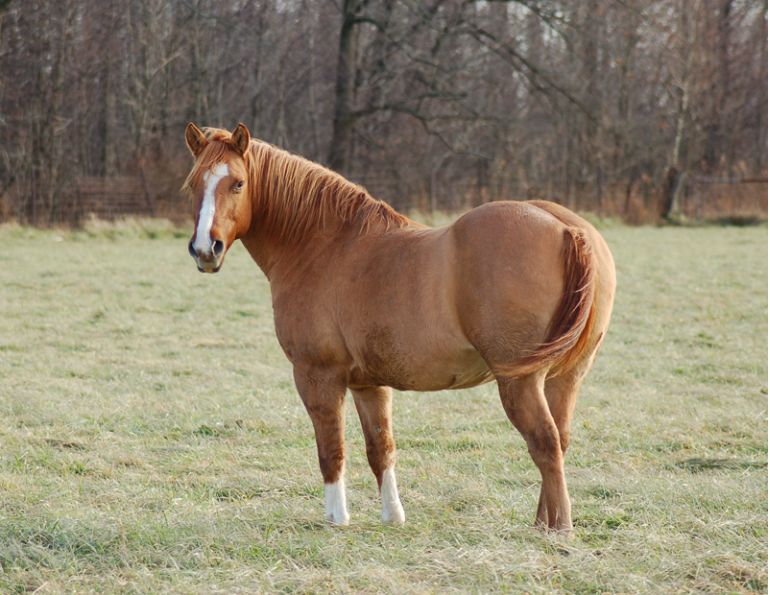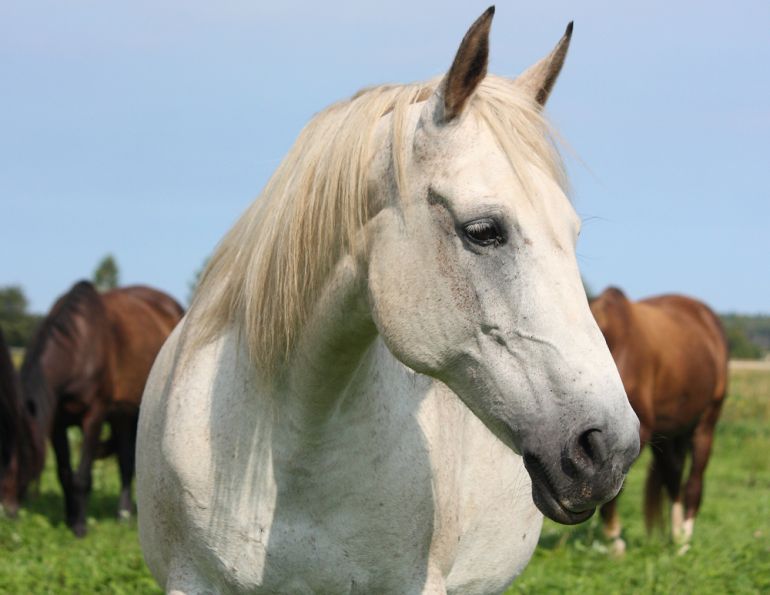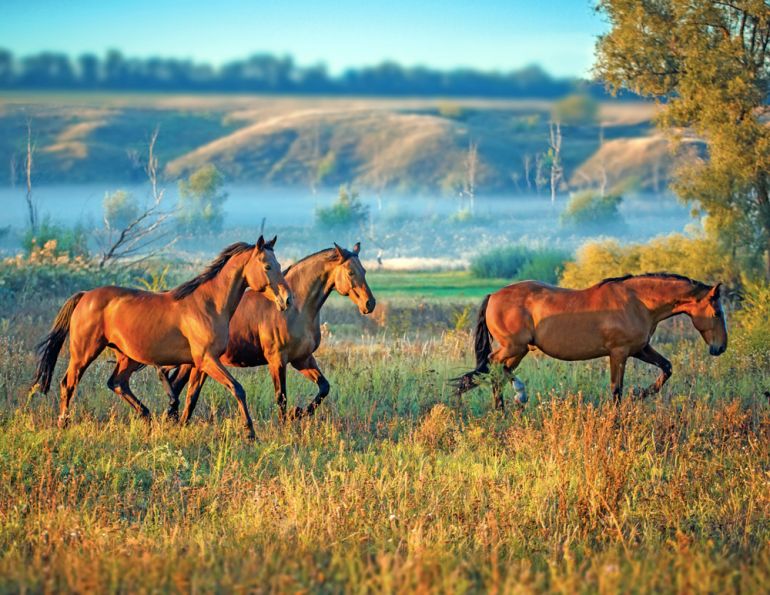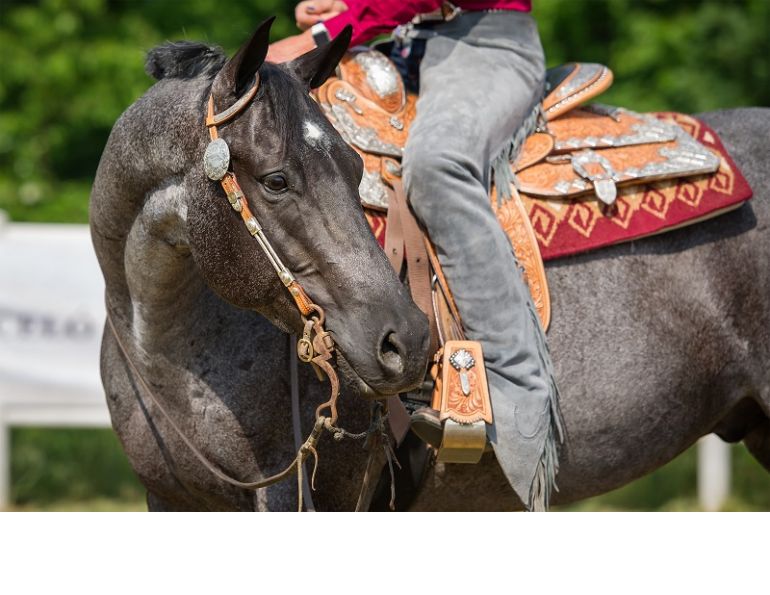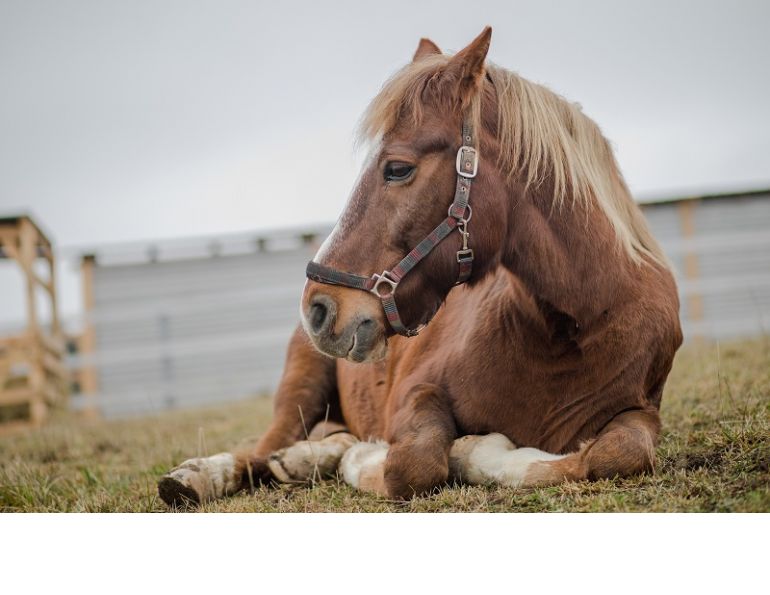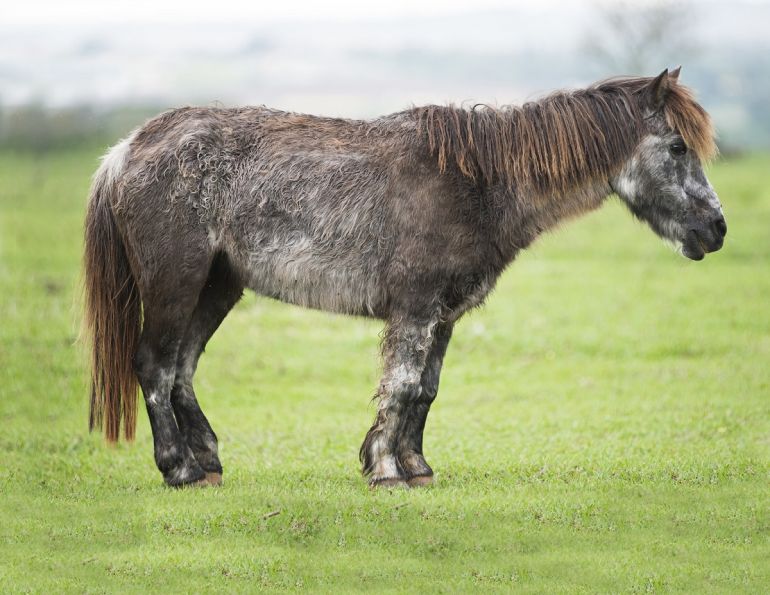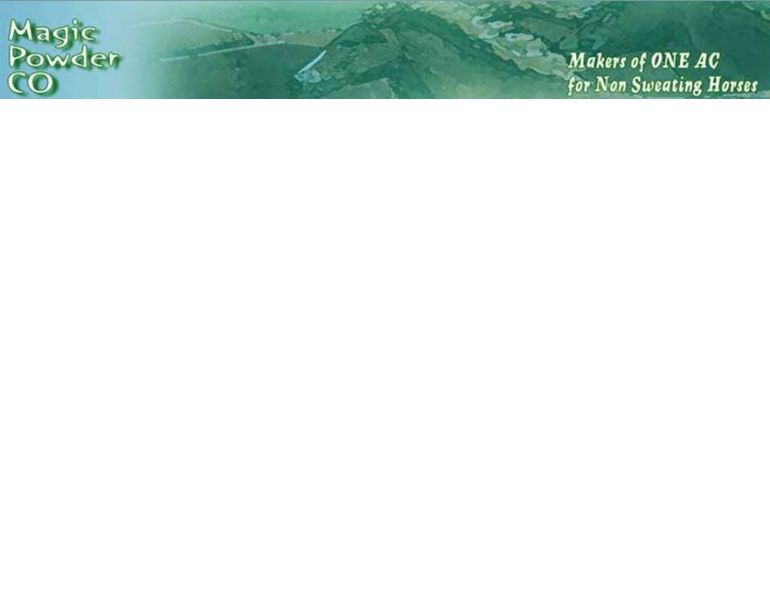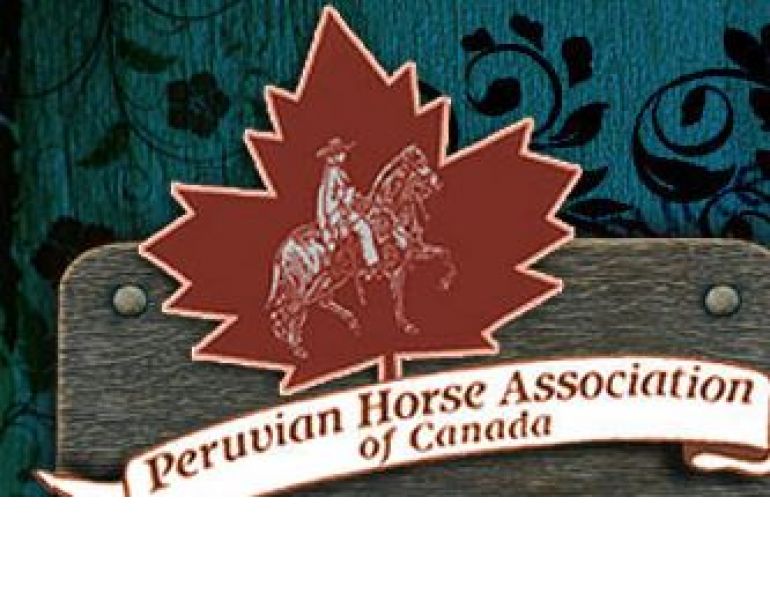By Dr. Robert A. Mowrey
In order to maintain internal body temperature and keep warm, a horse requires additional energy during cold weather. The exact amount of energy depends on the severity and extent of the cold period and individual characteristics of the horse. When environmental temperatures, including wind chill, drop below 45 degrees Fahrenheit (F) or seven degrees Celsius (C), called the critical temperature, significant amounts of energy are used by the horse to maintain its internal body heat.
The amount of energy required by the horse to meet daily energy needs is measured as digestible energy (DE) in calories. The critical temperature can be used to estimate increased energy needs which the horse must obtain from its diet. For each degree F decrease below the critical temperature, the horse requires a one percent increase in DE to maintain a consistent body temperature. Wind chill, moisture, and coat thickness will affect the critical temperature. The horse’s thick winter coat has an insulating effect against cold and wind. However, if the coat becomes wet, the hairs’ insulating properties are lost and the critical temperature will increase by 10 to 15 degrees F.
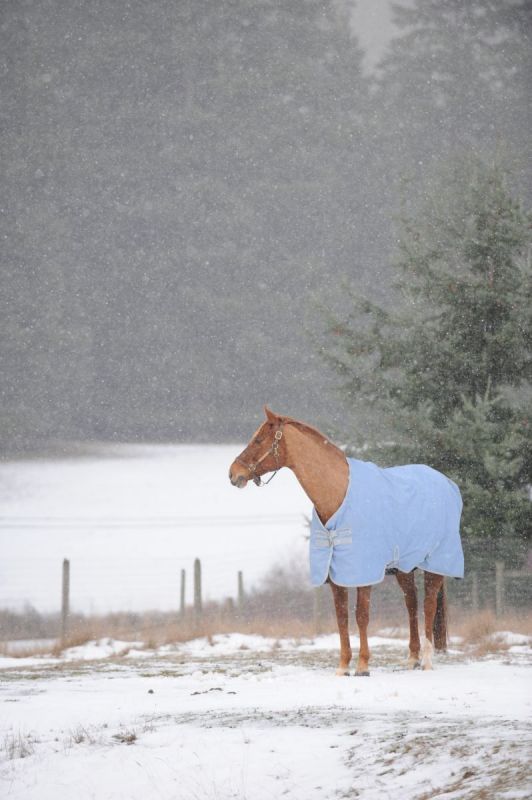
Monitor weather forecasts to determine changing conditions and cold periods in advance. Photo: Robin Duncan Photography
The following formula is used to calculate the increased DE requirements for a horse as a result of cold temperatures and wet, windy conditions: critical temperature F – actual temperature F = percent increase in DE required.
To convert C to F to use the above formula, use: degrees F = degrees C x 9/5 + 32.
Adjusting Energy Intake
By knowing weather conditions along with the properties of your horse’s daily ration, you can adjust energy intake accordingly. For example, for an 1100 pound horse at maintenance where there is a dry environmental temperature of 30 degrees F with a wind chill that results in an actual temperature of 25 degrees F, the steps would be as follows:
Step #1: Subtract the actual temperature, including the wind chill adjustment, from the critical temperature: 45 degrees F – 25 degrees F = 20 percent increase in DE requirements. In this example it is dry, but remember to add 10 to 15 degrees to the critical temperature to account for wet conditions if necessary.
Step #2: An average 1100 pound horse at maintenance requires 16.4 Megacalories (Mcal) of DE per day. Multiply as follows to calculate how many Mcal increase is needed based on the 20 percent requirement shown above: 16.4 Mcal x 20 percent = 3.28 Mcal increase. The requirement thus increases as follows: 16.4 Mcal + 3.28 Mcal = 19.68 Mcal DE per day.
Step #3: Next, you need to determine the amount of feed necessary to supply these increased calories. An 1100 pound horse typically consumes 19 pounds of ration daily, or 1.7 percent of his bodyweight. Because the recommended DE level of the ration (concentrate mix plus forage) fed to a horse at maintenance is 0.90 Mcal DE per pound of feed, we can calculate the increase in feed as follows: 3.28 Mcal ÷ 0.90 Mcal = 3.64 pounds of additional feed to provide 19.68 Mcal DE per day.
Step #4: Determine the total amount of feed the horse requires by adding the 3.64 pounds of additional feed to the 19 pounds of feed the horse requires under normal conditions: 19.0 + 3.64 = 22.64 pounds per day of total ration.
The Importance of Forage and Fat
Feedstuffs vary in the amount of internal heat produced when digested by the horse. Forages such as hay, which are digested by microbes located in the cecum and large intestine, produce more heat than concentrate mixes, which are digested by enzymes in the small intestine. Although concentrates contain more total DE per pound than hay, the amount of actual heat given off by the digestion process is significantly less. The best way to increase internal body heat while maintaining a safer, more consistent energy intake is to increase the intake of forage. A horse should consume at least 1.5 to 1.75 percent of its body weight as forage during cold periods. For example, a 1000 pound, mature horse would need to consume 15 to 17.5 pounds of hay daily to meet critical temperature needs during cold weather.

A horse should consume at least 1.5 to 1.75 percent of its body weight as forage during cold periods. Photo: Robin Duncan Photography
During prolonged periods of cold temperature - several days below the critical temperature — both the concentrate and forage portion of the diets should be increased in equal proportions. The energy density of the concentrate mix can be increased by adding fat in the form of four to eight ounces of vegetable oil per day, or by the addition of a commercial fat supplement according to label recommendations. Feeding of additional amounts of concentrate or increasing the energy density of the concentrate is especially important if the horse is in poor body condition with low body fat or is a “hard keeper.” The extra body fat provides an additional insulating effect against wind and also serves as an energy reserve that can be used when the horse is fed an energy-deficient diet.
The Importance of Water
Maintaining ample water intake is the most critical part of ensuring the health of your horse during cold weather. Under normal conditions, a horse will consume one gallon of water per 100 pounds of bodyweight, meaning an 1100 pound horse should consume 10 to 12 gallons of water daily. However, because horses prefer a water temperature of 45 to 65 degrees F (7 to 18 degrees C), as the water temperature decreases, a horse will consume less. The same 1100 pound horse may consume as little as one to three gallons of water daily when water temperature is 32 degrees F (0 degrees C). This can be dangerous for your horse. Low water intake is directly related to the increased incidence of impaction colic.
Water intake can be encouraged by increasing the amount of forage being fed prior to a drop in temperature. The resulting increase in dry matter encourages the horse to drink more water.
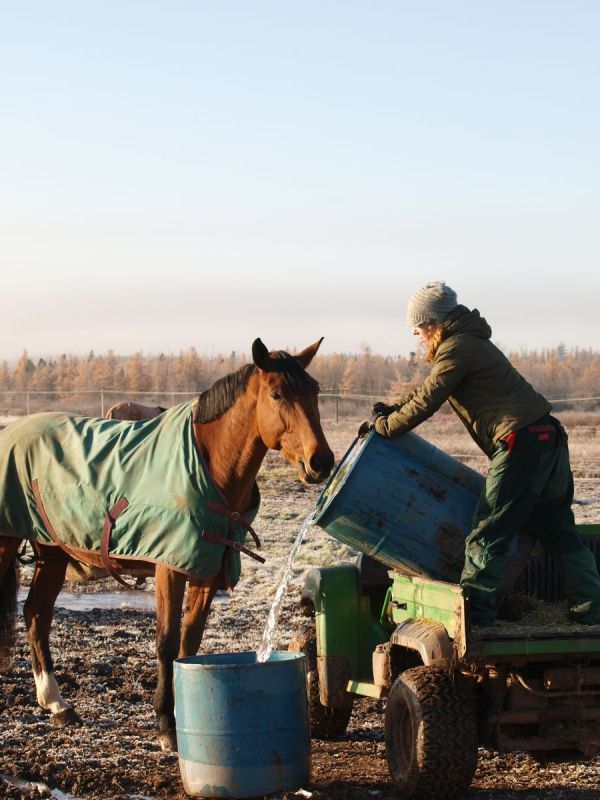
It is important to ensure your horse drinks adequate amounts of water during cold weather. As horses dislike drinking cold, icy water, installing heated water troughs or offering warm water at least twice a day is a good idea. Photo: Pam MacKenzie Photography
Concentrate mashes should be fed during the actual cold period when water temperature is below 45 degrees F. Feeding two to three gallons of hot water daily mixed into a mash with a textured or pelleted concentrate mix will provide additional water intake. To avoid gas colic, allow the mash to sit for 15 minutes; this will permit the feed to expand prior to feeding.
Break and remove ice from water tubs, making certain to provide water free-choice at all times. Consider installing a heated water trough if you live in an area that consistently gets very cold and icy in winter. If you are without heated water buckets, offer ten gallons of water at 65 degrees F or warmer twice daily.
Dr. Robert Mowrey is a professor emeritus of the Department of Animal Science in the North Carolina State College of Agriculture and Life Science: http://www.cals.ncsu.edu/an_sci/faculty/ramowrey.htm.
Article reprinted with kind permission from North Carolina State University. Visit the North Carolina State College of Veterinary Medicine Equine Medicine website at http://www.cvm.ncsu.edu/vhc/efac/equine/index.html.
Main Article Photo: Robin Duncan Photography
This article originally appeared in the October 2010 issue of Canadian Horse Journal - Central & Atlantic.




